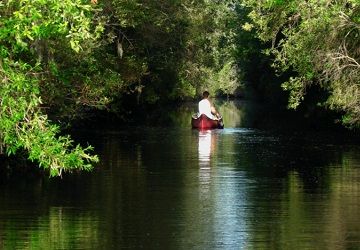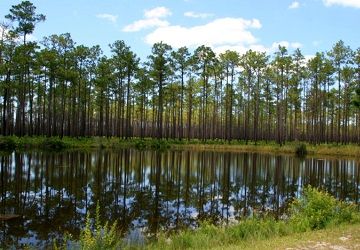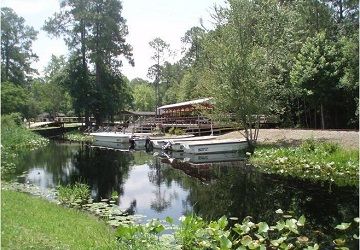Wildlife Adventures: Explore the Okefenokee National Wildlife Refuge
The Okefenokee Swamp in Georgia covers 438,000 acres and within it the wildlife refuge, in Georgia and Florida, consists of 402,000-acres.

Image Source: Sallie Gentry/USFWS
Paddling through a swamp may seem more like penance for bad behavior than the particularly fun part of a vacation, but that’s because you may not be thinking of canoeing through the Okefenokee National Wildlife Refuge. As you glide along some of the 120-miles of water trails, you enter a magical world where the bulging eyes of alligators peer out at you from the dark water and thick swaths of Spanish moss dangling from branches move in the wind with a ghostly flutter.
In fall and spring, the weather remains mostly temperate and the refuge offers an enthralling wildlife adventure. In spring the swamp resounds with the bellowing of breeding gators and the exuberant trilling of frogs, plus hundreds of yellow and white waterlily flowers line the trails.
Related: On Safari: See Rhinos in Zambia; Dream Trips: Galapagos Adventures, How to Choose ; A Tourist’s Guide to Exploring Yellowstone National Park
The Okefenokee Swamp in Georgia covers 438,000 acres and within it the wildlife refuge, in Georgia and Florida, consists of 402,000-acres. The largest national wildlife refuge in the eastern United States, the Okefenokee is a slow-moving river of water that comprises lakes, marsh-like prairies, and islands.

Image Source: National Wildlife Refuge
As we paddle the headwaters of the Suwannee River, we pass thickets of cypress trees that float almost magically on dense beds of peat, called "houses." Walk on them, and the land "quivers," a phenomenon that led the Native Americans to call this place "Okefenokee," or "the land of the trembling earth."
The Okefenokee harbors water fowl, wading birds, as well as gators, black bears and river otters.
When the sun comes out, it transforms the park. The alligators appear and so do birds and turtles. We spot a bony four-foot stretch of crooked mouth and tail basking in the sudden warmth. We see hawks, herons and hear a wood-pecker. The sun brings out hundreds of slider turtles, who living up to their names, splash from the shore into the water. The sun also transforms the black water into a mirror-like surface that creates upside reflections of the trees along the banks.
Just as we near Billy's Island, 15 miles into the heart of the swamp, and about two miles from our put-in site at Stephen C. Foster State Park, the sky grows gray again. In a soft drizzle, we hike through the island's pine forest. Although the air in this spot once buzzed with loggers’ saws, we hear only the wind in the pines.
Next, we navigate Minnie's Lake Run. Even in the rain, this narrow, curvy trail becomes our favorite. The green patches of lichen add color to the fluted gray trunks of the cypress trees. We maneuver around knobby cypress stumps, called “knees.”

Image Source: National Wildlife Refuge
We are thankful that we booked a cabin within the refuge at Stephen C. Foster State Park. After a day of paddling, often in the rain, we reward ourselves with hot chocolate, hot showers, and hot food. It’s been a memorable trip through the remarkable Okefenokee.
Entrances: You can access the Okefenokee through several entrances. The Suwannee Canal Recreation Area, a main entrance, is located 11 miles southwest of Folkston, GA. The Stephen C. Foster State Park, the west entrance, lies 17 miles east of Fargo, GA.
Accommodations: Stephen C. Foster State Park offers cabins and camping.
Activities: Okefenokee Adventures, among the outfitters offering tours, offers guided 90-minute pontoon boat outings, sunset tours, 4-hour canoe, kayak or motorized boat tour as well as multi-day and overnight trips.
ACTIVA BioACTIVE Bulk Flow Marks Pulpdent’s First Major Product Release in 4 Years
December 12th 2024Next-generation bulk-fill dental restorative raises the standard of care for bulk-fill procedures by providing natural remineralization support, while also overcoming current bulk-fill limitations.